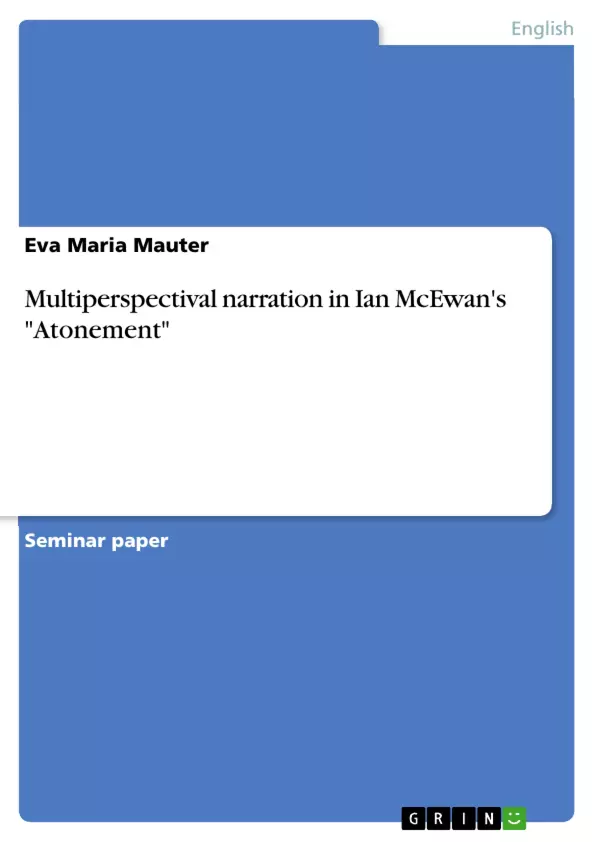In this thesis Ansgar Nünning's concept of multiperspectival narration is applied to Ian McEwan's Atonement in great detail. Hence, the thesis is of interest to everybody who is concerned with "perspective" or "multiperspectivity" in narrations as well as students of Ian McEwan's work.
In post-modern english literature, Ian McEwan has received considerable attention from critics and scholars and his writing is certainly most noteworthy. In his best-selling novel "Atonement", McEwan employs a multitude of subjective perspectives which is not only a key element for suspense and understanding the plot but also an instrument of reception control. In order to gain access to the narrational strategies of the novel and for a deeper understanding of McEwan's perfect controll of narratological and stylistic devices, Ansgar and Vera Nünning's concept to analyze multiperspectivity in narration is applied to "Atonement".
Although A. and V. Nünning's concept augments modern narratology with an extraordinary instrument to analyze perspectivity, it lacks application so far. Ian McEwan's "Atonement" provides an excellent field for exploring multiperspectivity. So this essay will use A. and V. Nünning's categories in order to analyze the structure of perspectives and its controlling functuin in McEwan's "Atonement".
Therefore, the general concept of A. and V. Nünning concerning multiperspectivity is introduced at first. It is necessary to have a close look at forms of multiperspectivity and the single perspectives first in order to analyze the structure of perspectives which are explored in the paradigmatic and the syntagmatic dimension. Even if the structures of perspectives may function already as a controlling strategy, control of reception will be explained in more detail.
Then, this concept is applied to Ian McEwan's narration Atonement. Before the structure of the perspectives is explored in the paradigmatic and the syntagmatic dimension, the forms of multiperspectival narration in Atonement are stated. The various strategies to control the reception are summerized and the first impression of the effect of multiperspectivity in Atonement is briefly described.
This in-depht analysis of Ian McEwan's "Atonement" with A. and V. Nünning's concept of multiperspectivity establishes a fundamental comprehension of McEwan's use of perspectivity in narration and provides the reader with a profound narratological background for the understanding of "Atonement".
Inhaltsverzeichnis (Table of Contents)
- Introduction
- Multi-perspectival Narration
- Forms of Multi-perspectival Narration
- Single Perspectives
- Structures of Perspectives
- the Paradigmatic Dimension
- the Syntagmatic Dimension
- Control of the Reception/Controlling Strategies
- Closed or Open Structure
- "Perspektivensteuerung" - Control of the Reception/Controlling Strategies
- Framing
- Effect of Multi-perspectivity
- Multi-perspectival Narration in Atonement
- Forms of Multi-perspectival Narration in Atonement
- Single Perspectives in Atonement
- Structure of the Perspectives
- the Paradigmatic Dimension
- the Syntagmatic Dimension
- Control of Reception/Controlling Strategies
- Effect of Multi-perspectivity in Atonement
- Closing Words
Zielsetzung und Themenschwerpunkte (Objectives and Key Themes)
This essay aims to analyze the structure of perspectives and its controlling function in Ian McEwan's Atonement, using A. and V. Nünning's categories of multi-perspectival narration. The paper explores the different forms, single perspectives, and structures of perspectives in the novel. It then examines the controlling strategies employed by McEwan, focusing on the open or closed nature of the perspective structure, the strategies that support or disrupt reception control, and the concept of framing.
- Multi-perspectival Narration
- Forms of Multi-perspectival Narration
- Structure of Perspectives
- Control of Reception
- Effect of Multi-perspectivity in Atonement
Zusammenfassung der Kapitel (Chapter Summaries)
The first chapter introduces the general concept of multi-perspectivity according to A. and V. Nünning, examining different forms of multi-perspectival narration, single perspectives, and the structure of perspectives in both the paradigmatic and syntagmatic dimensions. The chapter also explores different controlling strategies, including open or closed structures, strategies that support or disrupt reception control, and framing.
Chapter three applies these concepts to Ian McEwan's Atonement, exploring the different forms of multi-perspectival narration present in the novel, particularly focusing on the structure of perspectives in the paradigmatic and syntagmatic dimensions. It also examines the controlling strategies employed by McEwan to manage the reader's reception of the narrative.
Schlüsselwörter (Keywords)
The primary focus of this essay is on the analysis of multi-perspectival narration in Ian McEwan's Atonement. Key terms and concepts include multi-perspectivity, forms of multi-perspectival narration, single perspectives, structure of perspectives (paradigmatic and syntagmatic dimensions), control of reception, controlling strategies, framing, and the effect of multi-perspectivity in Atonement.
- Quote paper
- Eva Maria Mauter (Author), 2004, Multiperspectival narration in Ian McEwan's "Atonement", Munich, GRIN Verlag, https://www.grin.com/document/68235



